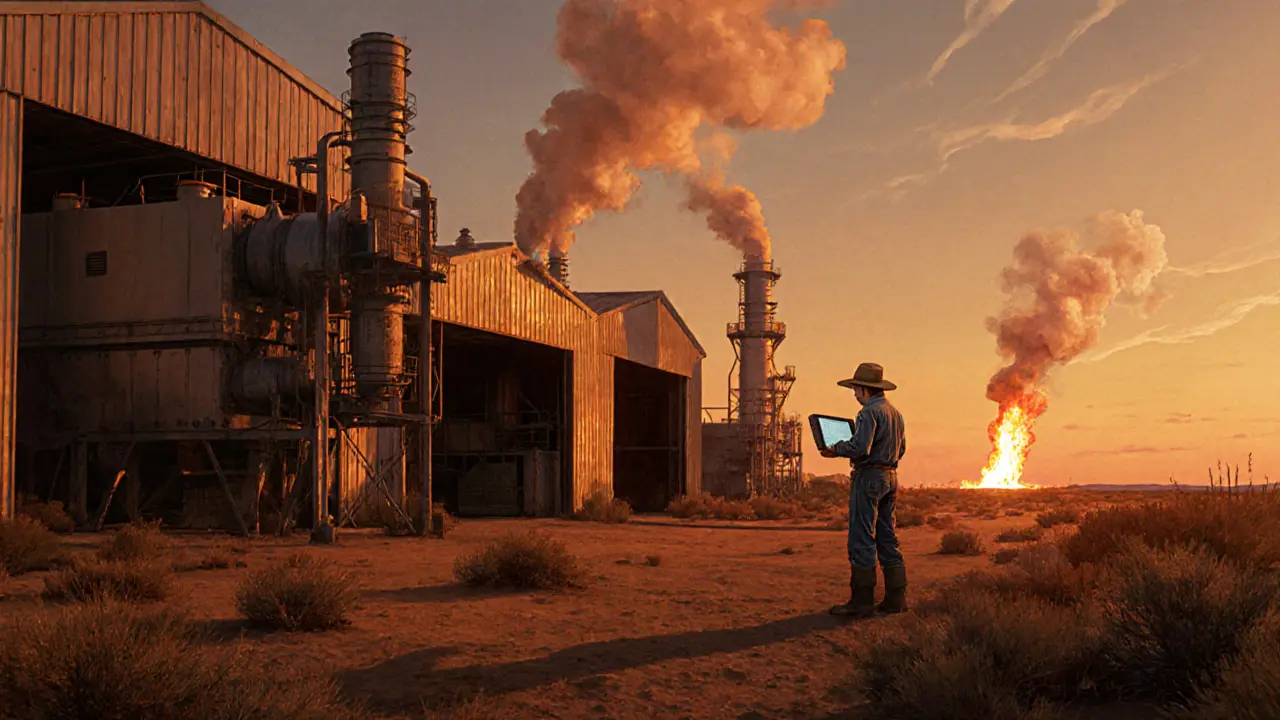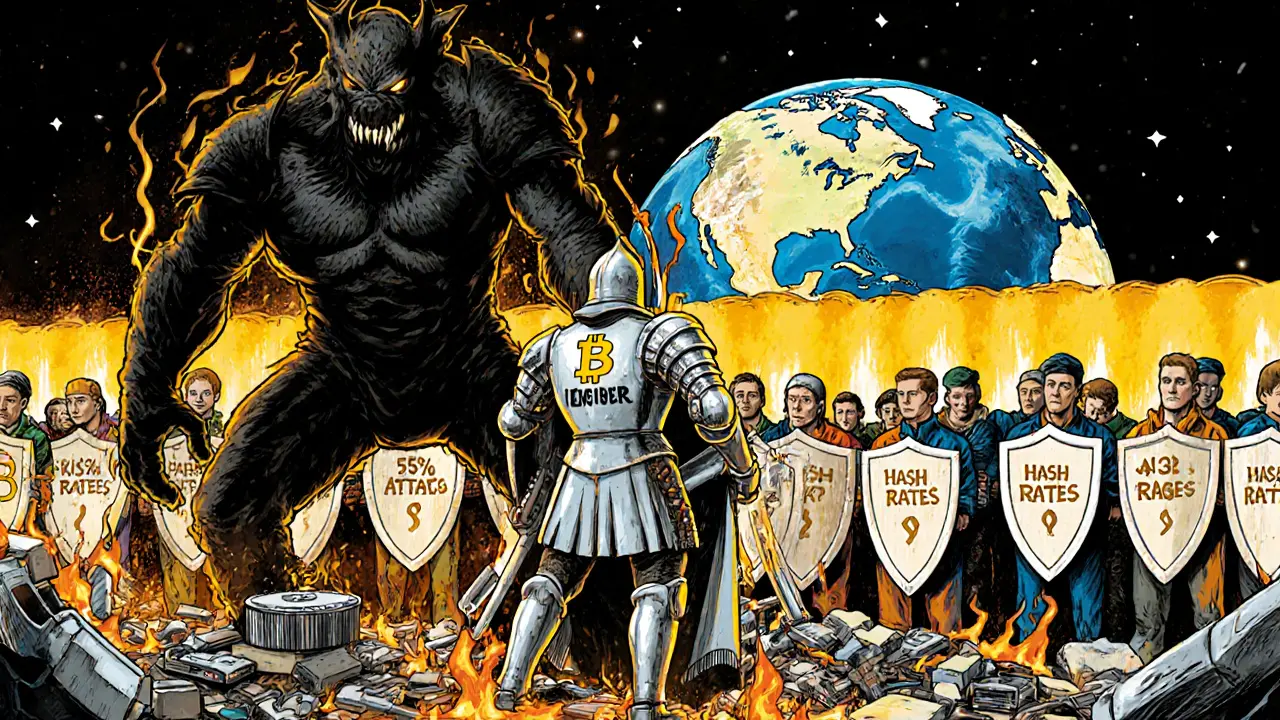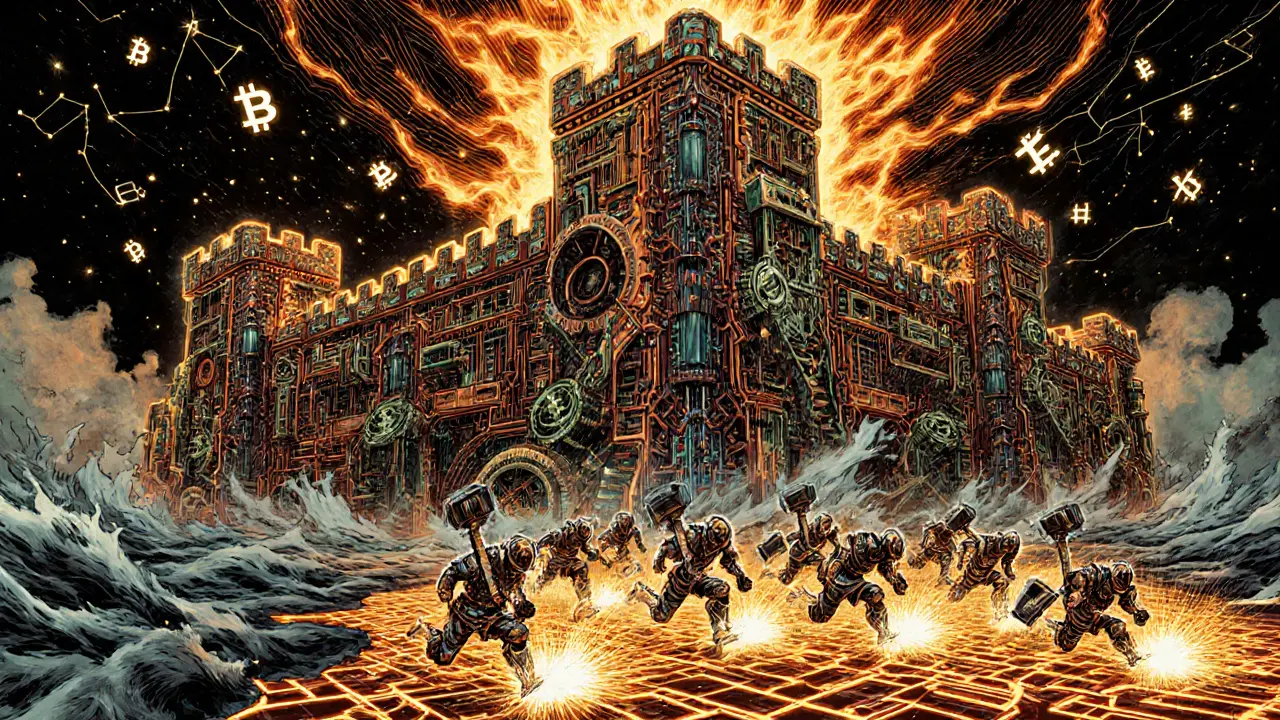Bitcoin Mining Profitability Calculator
Input Parameters
Current Bitcoin Mining Context
Current hash rate: 620 exahashes/sec (Oct 2025)
Difficulty adjustment: 2.25% increase (12th consecutive increase)
Next halving: April 2026 (block reward drops 3.125%)
Important note: Mining profitability depends heavily on location-specific electricity costs. Only 58.3% of hash rate uses renewable energy, but most miners operate at $0.025-$0.05/kWh to be profitable.
Enter your parameters and click Calculate to see profitability analysis.
When you hear that Bitcoin’s network hash rate hit 620 exahashes per second in October 2025, what does that actually mean? It’s not just a big number-it’s the collective power of millions of machines racing to solve complex math problems, securing the entire blockchain. Think of it like a digital fortress. The higher the hash rate, the harder it is for anyone to break in. And right now, that fortress is growing stronger than ever.
What Is Hash Rate, Really?
Hash rate measures how many calculations a blockchain network can perform every second. It’s measured in hashes per second (H/s), but with Bitcoin, you’re dealing with numbers so large they need bigger units: terahashes (TH/s), petahashes (PH/s), and exahashes (EH/s). One exahash equals one quintillion calculations per second. That’s 1,000,000,000,000,000,000 tries to guess the right answer-every single second.
This isn’t theoretical. Bitcoin’s hash rate has jumped from 40 EH/s in January 2021 to over 600 EH/s today. That’s a 1,200% increase in just over four years. Why? Because more miners are joining, and the machines they use are getting faster and more efficient. The current all-time high of 650 EH/s in May 2024 shows how quickly this can change.
Hash rate isn’t just a number-it’s the backbone of Bitcoin’s security. The more computational power on the network, the more expensive and difficult it becomes to launch a 51% attack. According to CryptoQuant’s October 2025 report, launching such an attack on Bitcoin would cost over $14.8 billion in hardware and $38.7 million per day in electricity. That’s not just expensive-it’s practically impossible for any single entity to pull off.
How Hash Rate Keeps Bitcoin Secure
Bitcoin’s security doesn’t come from passwords or firewalls. It comes from math and scale. Every 10 minutes, a new block is added to the chain. Miners compete to solve a cryptographic puzzle. The first one to solve it gets rewarded with new Bitcoin. This process is called proof-of-work.
Here’s the key: the network automatically adjusts the difficulty of that puzzle every two weeks. If hash rate goes up, the puzzle gets harder. If miners drop off, it gets easier. This keeps the block time steady at 10 minutes, no matter how many machines are running.
The October 28, 2025, difficulty adjustment increased by 2.25%. That’s the 12th consecutive increase this year. It’s a direct response to the growing hash rate. More miners mean more competition. The system responds by raising the bar so no one gets too far ahead.
This self-correcting mechanism is what makes Bitcoin resilient. Even if one mining farm shuts down, others keep going. There’s no single point of failure. And unlike centralized systems, you can’t just shut down Bitcoin by taking out a server. You’d have to take down thousands of them-spread across continents.
Who’s Mining, and Where?
Five years ago, China controlled over 65% of Bitcoin’s hash rate. Then came the 2021 ban. Overnight, the map changed.
Today, the United States leads with 48.9% of global hash rate, according to the Cambridge Centre for Alternative Finance. Kazakhstan is second at 16.2%, followed by Russia at 11.1% and Canada at 9.3%. The shift wasn’t accidental. Texas, in particular, became a magnet for miners thanks to cheap electricity, deregulated energy markets, and tax incentives.
One miner in Texas, known online as “TexasHash,” runs his operation next to a natural gas well. He’s paying just $0.025 per kWh-less than a quarter of the U.S. average of $0.147. He’s not just saving money; he’s turning waste gas into secure blockchain power.
But it’s not just individuals. Big companies are in too. Marathon Digital and Riot Platforms together control 8.7% of Bitcoin’s total hash rate. And with BlackRock’s planned Bitcoin Mining ETF (MINR) set to launch in February 2026, institutional money is expected to pour in. This isn’t just hobbyist mining anymore-it’s big business.

Hardware Wars: ASICs and Efficiency
Not just anyone can mine Bitcoin profitably anymore. You need specialized hardware: ASIC miners. These are chips built for one thing only-hashing. Regular computers or even gaming GPUs are useless now.
The current king is Bitmain’s Antminer S21, released in June 2024. It does 200 TH/s while using 18.5 joules per terahash. That’s a big improvement over the S19, which used 22 joules per TH. Efficiency matters because electricity is 73.5% of a miner’s costs, according to a Reddit survey of 1,247 miners in October 2025.
But buying an ASIC isn’t easy. Bitmain’s official store has a 2.8/5 rating on Trustpilot, with complaints about 4- to 8-week delays. Some miners wait months just to get their machines. And once they arrive, they generate 3,360 BTU/hour of heat. That’s like running three space heaters nonstop. Cooling adds another 15-20% to operating costs.
Next up? The Antminer S22, expected in Q1 2026. It’s rumored to use 5nm chips and hit 300 TH/s at just 15 joules per TH. That’s a 20% efficiency gain. If it delivers, the next wave of mining will be even more centralized-only those with deep pockets and access to cheap power will stay in the game.
Energy Use and the Environmental Debate
Bitcoin mining uses a lot of electricity. The Cambridge Bitcoin Electricity Consumption Index puts annual consumption at 121.72 terawatt-hours-about 0.55% of global usage. That’s more than the entire country of Argentina.
But here’s the twist: 58.3% of Bitcoin’s hash rate now runs on renewable energy, according to the Bitcoin Mining Council’s Q2 2025 report. Miners are drawn to stranded energy-waste gas from oil fields, excess hydro power during rainy seasons, or surplus wind at night. These aren’t ideal sources for cities, but they’re perfect for mining rigs.
Still, critics aren’t convinced. Dr. Alex de Vries, writing in Joule in June 2025, warned that if Bitcoin’s hash rate keeps growing at 35% per year, it could consume 1.5% of global electricity by 2027. That’s a red flag for climate policymakers.
Meanwhile, Ethereum ditched proof-of-work entirely in 2022. It slashed its energy use by 99.95%. Dr. Emin Gün Sirer argues this proves hash rate isn’t necessary for security. But Bitcoiners say: “You can’t replace battle-tested with theoretical.” Bitcoin’s security has been tested for 16 years. Ethereum’s proof-of-stake model? Less than three.

Is Mining Still Profitable?
Let’s be real: most people who tried mining Bitcoin in 2025 lost money.
One Reddit user, u/MiningMaster42, spent $12,500 on three Antminer S21 units. After six months, he earned 0.045 BTC-worth $3,150 at current prices. That’s a 75% loss. Why? Difficulty kept rising. Electricity prices didn’t drop. And the manufacturer’s projected returns? Unrealistic.
Profitability isn’t just about hardware. It’s about location, timing, and luck. Miners in Texas or Idaho with access to $0.03/kWh power are thriving. Those in New York or California, where electricity costs $0.25/kWh or more, are shutting down. New York’s two-year mining moratorium, extended through December 2025, has forced many out.
Even large mining companies are feeling the squeeze. The Bitcoin block reward drops by 3.125% in April 2026. That’s the next halving. Historically, this triggers a short-term drop in hash rate as weaker miners get squeezed out. Fidelity Investments predicts a 15-20% decline in hash rate after the halving. But if Bitcoin’s price rises as it has in past cycles, the network will recover-and come back stronger.
What’s Next for Hash Rate?
Analysts at Messari predict Bitcoin’s hash rate will hit 1,000 EH/s by Q3 2026. That’s 60% more than today. How? More institutional money, better chips, and smarter energy use.
Taproot3, activated in October 2025, already improved mining efficiency by 3.7%. That’s a small boost, but every bit helps. And with new mining facilities like Bitfarms’ 100 MW Texas plant adding 12 EH/s to the network, the growth curve isn’t slowing.
But there’s a catch. As hash rate rises, so does centralization. In 2019, the top three mining pools controlled 65% of Bitcoin’s power. Today, it’s down to 42%. That’s progress. But 65% of new mining capacity is now in North America. That’s a new kind of risk-if one country changes its policy, the whole network could be affected.
Still, Bitcoin’s hash rate remains the most reliable indicator of network health. It’s not perfect. It’s not clean. But it’s real. And for now, it’s working.
Why does Bitcoin’s hash rate keep going up?
Bitcoin’s hash rate rises because more miners join the network, and new ASIC miners become more powerful and efficient. As Bitcoin’s price increases or mining becomes more profitable, more capital flows into mining hardware. The network automatically adjusts difficulty to maintain a 10-minute block time, which encourages even more investment to stay competitive.
Can a 51% attack happen on Bitcoin?
Technically yes-but it’s practically impossible. A 51% attack requires controlling more than half of the network’s total hash rate. As of October 2025, that would cost over $14.8 billion in hardware and $38.7 million per day in electricity. No single entity has that kind of capital, and even if they did, the market would crash, making the attack worthless.
Is Bitcoin mining bad for the environment?
It uses a lot of electricity-about 121.72 TWh annually. But 58.3% of that power comes from renewable or stranded sources like waste gas and excess hydro power. Bitcoin miners are often the only customers for energy that would otherwise be flared or wasted. While the carbon footprint is still significant (62.4 million tons of CO2/year), the industry is rapidly shifting toward cleaner energy.
Should I start mining Bitcoin in 2025?
Unless you have access to electricity under $0.05/kWh and technical expertise to manage heat and hardware, it’s not worth it. Most retail miners lose money due to rising difficulty, high power costs, and hardware delays. Buying Bitcoin directly is far more reliable than trying to mine it yourself.
How does hash rate affect Bitcoin’s price?
Historically, hash rate has led price movements by 60-90 days. When miners invest in more equipment, it signals confidence in Bitcoin’s future. That often precedes price increases. The correlation between hash rate and price is 0.87 over the past five years-strong evidence that network health influences market sentiment.
What happens to hash rate after the next Bitcoin halving?
After the April 2026 halving, the block reward drops from 6.25 BTC to 4.6875 BTC. Miners with high operating costs will shut down, causing a temporary 15-20% drop in hash rate. But historically, prices rise afterward as supply tightens. The network typically recovers within 3-6 months as efficiency improves and new capital enters.

Kymberley Sant
November 1, 2025 AT 13:52Matthew Affrunti
November 1, 2025 AT 20:52mark Hayes
November 2, 2025 AT 19:24Masechaba Setona
November 4, 2025 AT 07:14Jason Coe
November 6, 2025 AT 02:06alvin Bachtiar
November 7, 2025 AT 12:34Eliane Karp Toledo
November 8, 2025 AT 07:11Phyllis Nordquist
November 9, 2025 AT 17:50Brett Benton
November 11, 2025 AT 15:58David Roberts
November 11, 2025 AT 16:43Josh Serum
November 12, 2025 AT 18:13Beth Devine
November 13, 2025 AT 04:09Edgerton Trowbridge
November 14, 2025 AT 02:51Helen Hardman
November 15, 2025 AT 15:42Hanna Kruizinga
November 16, 2025 AT 22:52Monty Tran
November 16, 2025 AT 23:29Bhavna Suri
November 18, 2025 AT 06:28Wesley Grimm
November 19, 2025 AT 13:53Brian McElfresh
November 20, 2025 AT 00:07Derek Hardman
November 21, 2025 AT 20:41